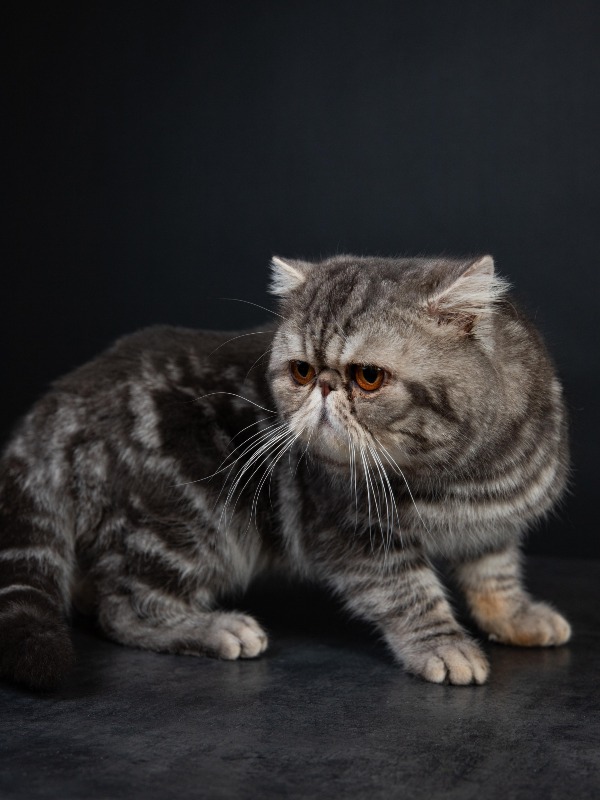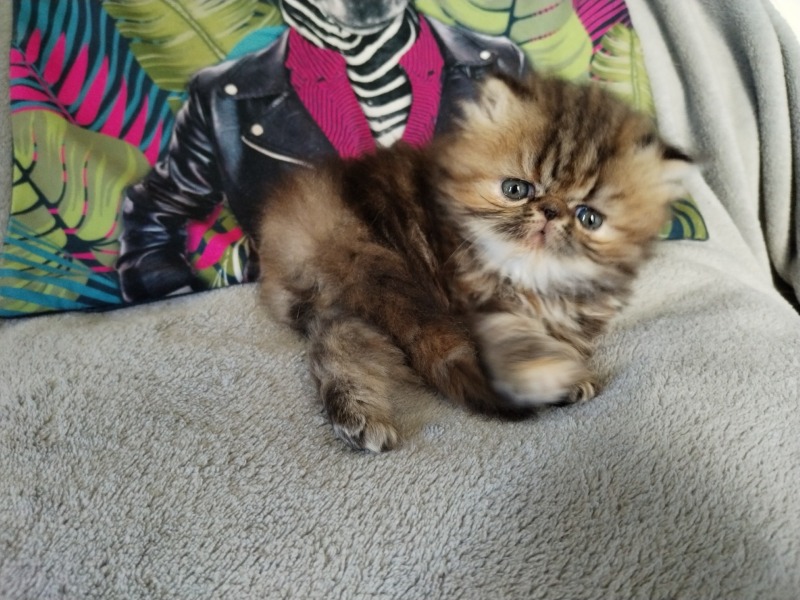Persian
Welcome to our page dedicated to the breed of cat persian!
Here, you will find all the useful information about persian. This descriptive profile will allow you to discover the aspects of this breed. You can notably consult information about the average price, monthly and annual upkeep expenses, their health, name ideas, as well as their official recognition by competent authorities.
Explore this page to discover everything you need to know.
Overall description of the breed
The Persian cat likely traces its origins to ancient Persia, which corresponds to modern-day Iran. Its name, Persian, is closely resonant with its historical roots. The luxurious coat that characterizes this breed is the result of a natural genetic mutation. In the 17th century, this distinguished-furred feline was spotted by an Italian nobleman named Pietro Della Valle, who had the privilege of introducing this marvel to Europe in 1626.
However, the first feline exhibitions of the 19th century grouped all cats originating from the East under the generic term "Orientals." It wasn't until later, towards the end of the 19th century, with the rise of cat breeding and exhibitions, that long-haired cats from distant lands like Persia, Turkey, or Afghanistan were recognized as a distinct breed.
It was at the illustrious Crystal Palace cat exhibition in 1871 that Persian cats, with their characteristic appearance, shone among the eagerly anticipated breeds. They quickly captured the hearts of cat enthusiasts with their unique and endearing look. Furthermore, Queen Victoria of England, a great admirer of the breed, helped explode their popularity at the time. Since then, the Persian has undergone a considerable transformation, evolving into a round-faced, short-nosed cat thanks to the careful attention of passionate breeders.
Its success also extended to the United States, where it was imported in the late 19th century. Over time, it managed to dethrone the Maine Coon from its privileged place in the hearts of Americans. In just over a century, the Persian has become the most beloved cat breed in the world, celebrated for its stunning beauty and gentle nature.
The character of the Persian is exceptional, combining gentleness, affection, and a remarkable closeness to humans. Generations of breeders have worked diligently to eliminate wild and hunting instincts, giving the Persian its delicate personality. Thus, it has established itself as a perfect feline companion for domestic life.
The palette of colors and patterns in Persian cats is vast and fascinating. Various shades such as black, blue, red, cream, white, tortoiseshell, blue-cream, cinnamon, silver, and gold are available for cat lovers to admire. Some have markings like blotched Tabby, tabby mackerel, or spotted tabby, while others sport a subtle blend of white and other colors, solid or tabby. Some may also have points similar to Siamese cats and are referred to as Colourpoint Persians. Variations like solid colors (Himalayans) further enrich the charm of this breed, sparking the passionate interest of breeders and enthusiasts.
As adults, the weight of a Persian cat can vary considerably depending on its variety, ranging between 2.5 and 6.5 kg (5.5 to 14 lb). The extraordinary success of the Persian over the centuries is rooted in its captivating aesthetics, gentle personality, and historical heritage that has captivated the hearts of cat lovers worldwide.
Awareness of acquiring an animal
Each animal is a sensitive being, deserving love, attention and care.
When you choose to adopt an animal, you take on the responsibility of ensuring its health and well-being throughout its life.
To learn more about animal welfare, we invite you to consult our FAQ by clicking the button below:
Origins
The Persian cat, with its majestic appearance and luxurious fur, finds its origins in the vast expanses of ancient Persia, the present-day Iran. Imported into Europe in the 17th century, these cats captivated the aristocracy with their exotic beauty and grace. It is thought that modern Persians are the result of crossbreeding between these original Persian cats and European long-haired breeds, thus creating the luxurious pedigree we know today.
History
The history of the Persian cat is closely linked to that of the nobility and the European elite. Introduced to Italy and France in the 17th century, they quickly became a symbol of prestige. In the 19th century, their popularity spread to England, where selective breeding began to standardize their appearance. Today, the Persian is one of the most beloved and recognized cat breeds in the world, famous for its elegant demeanor and calm temperament.
Standard
The Persian breed standard highlights its long and dense fur, wide and round head with full cheeks, small rounded ears, and large round and expressive eyes. Its most distinctive feature is its short nose, giving the appearance of a flat face. The breed comes in a multitude of colors and patterns, including solids, tabbies, colorpoints, and more. Their body is sturdy and muscular, with a relatively low stature.
Physical characteristics
Persian cats are renowned for their long and sumptuous fur, requiring regular maintenance. They have a strong bone structure, a massive body, and a characteristic wide head with a flat profile. Their eyes, often of a deep blue or bright copper, add to their sweet and dreamy expression. Despite their delicate appearance, Persians are quite robust and can come in a variety of colors and patterns.
Character
Persians are appreciated for their calm temperament and gentle nature. They prefer a peaceful environment and are perfectly content to spend hours lounging. Although they are less inclined to adventure and active play, they show affection towards their owners and enjoy cuddles. Their placid temperament does not make them any less curious, but they approach life with remarkable serenity.
Life expectancy
Persian cats have an average lifespan of 12 to 17 years. Like all purebreds, they can be prone to specific health problems, such as kidney and heart diseases, as well as respiratory issues due to their flat face. Special attention to their health, through regular veterinary visits and a balanced diet, can help ensure a long and healthy life.
Exercise and activity needs
Although Persians are less active than other breeds, they benefit from moderate mental and physical stimulation. Soft games and interactive play sessions can help to keep them interested and in shape. Their calm nature does not mean they should be inactive, and toys that encourage light movement or the use of their intellect can be very beneficial.
Recommended diet
A high-quality diet, specifically formulated to meet the nutritional needs of long-haired cats with slower metabolisms, is essential for Persians. Their diet must be high in protein and moderate in fat, with constant access to fresh water. Special attention should be given to the size of the kibble, tailored to their small mouths, to encourage good dental hygiene.
Training and obedience
Persians are intelligent cats and can be trained to follow simple routines, such as using the litter box and the scratching post. Their calm nature makes training less demanding, but they respond well to positive reinforcement. Starting education at a young age and being consistent in routines helps to establish good habits.
Behavior with children
The gentle and patient temperament of Persians makes them excellent companions for families with children. They are generally tolerant of attention and can even partake in calm games. However, as with all breeds, it is important to teach children how to respectfully interact with cats, avoiding rough play or improper handling to ensure positive interactions.
Compatibility with Other Animals
En raison de son caractère pacifique, le Persan s'entend généralement bien avec d'autres animaux domestiques, y compris les chiens et les autres chats. Une introduction progressive et une supervision initiale sont recommandées pour favoriser des relations harmonieuses.
Grooming needs
Grooming is essential for Persians because of their long and dense fur. Daily brushing helps prevent knots and hairballs while keeping the fur shiny and healthy. It's also advisable to regularly clean their eyes to avoid buildup due to their narrow tear ducts. Periodic baths may be necessary to keep their fur clean and reduce allergens.
Health
Persians may be predisposed to certain health conditions, such as kidney diseases, heart problems, and respiratory difficulties due to their flat faces (brachycephaly). Regular dental care is also important to prevent periodontal diseases. Regular veterinary visits and genetic testing can help monitor and prevent these health issues.
Average price
The cost of a Persian kitten can vary widely, generally between 500 and 5000 euros, depending on the lineage, pedigree, and physical appearance. Kittens intended for showing can cost more, while those adopted mainly for companionship may be less expensive. It is crucial to deal with a reputable breeder to ensure the health and well-being of the animal.
Expenses
Besides the purchase price, Persian owners should anticipate ongoing expenses for grooming, quality food, veterinary care, vaccines, and accessories such as beds and toys. The costs of professional grooming and preventive healthcare can also add up, making owning a Persian potentially expensive in the long term.
Name ideas
The royal and elegant character of the Persian often inspires majestic or exotic names. Name ideas include Persephone, Sultan, Cleopatra, Darius, Anastasia, or Nefertiti. Names reflecting softness and grace, such as Angel, Silk, or Velvet, are also popular among Persian owners.
Legislation and regulation
There is no specific legislation governing the ownership of Persian cats. However, owners must comply with general animal welfare laws, which include the obligation to provide proper care, food, shelter, and medical attention. In some areas, pet registration and vaccination against certain diseases may be required.
Official recognition
The Persian cat is one of the oldest recognized breeds and is accepted by all major feline associations, such as the Cat Fanciers' Association (CFA), the International Cat Association (TICA), and the Fédération Internationale Féline (FIFe). This official recognition ensures the maintenance of the breed's high standards through responsible breeding programs.
Pedigrees
Pedigrees, certifying the purity of a Persian's lineage, are available from certified breeders and feline associations. These documents provide valuable information on the cat's ancestry, show titles, and potential genetic predispositions to certain health conditions, thus enabling owners to better understand and care for their pet.
Destination and usage
Traditionally, Persians have been raised to be luxury companions, valued for their beauty and calm temperament. Although they participate in cat shows and can be used in selective breeding programs, their primary role remains that of affectionate family members, providing comfort and companionship to their owners.
Prohibitions
There are no specific bans on owning Persian cats. However, some housing may impose restrictions on pet ownership in general. Therefore, prospective Persian owners should check their housing policies regarding pets to ensure they can legally accommodate a Persian cat in their home.
Breeders of Persian
Want to see more breeders of Persian?
Check out the page of our directory listing all breeders of PersianClassified Ads of Persian
Breed clubs of persian
No of persian breed clubs are currently registered on Preeders.
If you would like to highlight your breed club, sign up for free now and be the first to appear on this page.




